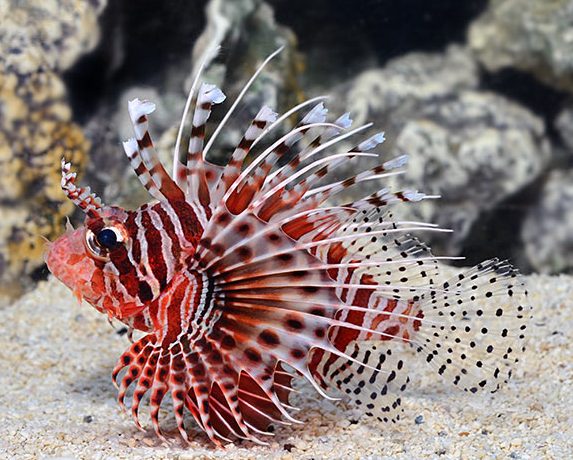
The Mombasa Lionfish is a welcomed member of the extremely popular Lionfish group of marine fish. This species is oftentimes confused for the Antennata or Spotfin Lionfish as the two are very similar in appearance. Mombasa Lionfish can be distinguished from Antennata Lionfish by their shorter pectoral fin filaments, larger eyes, unique barring pattern on the base of the tail, and lack of the series of dark spots on the pectoral fins. Just like its better-known cousin, the Mombasa Lionfish is a beautiful fish with unique pectoral fin filaments that resemble wings.
The Mombasa Lionfish originates from the Indian Ocean, and is infrequently exported from East Africa, Maldives, and Sri Lanka. These fishes frequent deeper water and can be found on offshore reefs and reef slopes varying in depth from 50-130 feet.
The spines on the dorsal, anal fins of the Mombasa Lionfish are venomous, so use extreme caution when cleaning the aquarium or handling this species. If you are stung, the reaction will be similar to a bee sting only a little stronger.
The Mombasa Lionfish should be housed in a dimly lit 50 gallon or larger aquarium with a few overhangs and structures for adequate hiding places. The ideal setup should be aquascaped with live rock to provide shelter, along with open areas for swimming to accommodate the beautiful open fin display of this species. This species is a nocturnal hunter, and they are normally found perched on rockwork or under an overhang during the day. Keep in mind that the predatory Mombasa Lionfish will consume smaller fish, shrimp, and other crustaceans in the tank.
When first introduced into the aquarium, freshwater Ghost (Glass) Shrimp should be used to entice this fish to eat. Its diet should include meaty foods such as live shrimp, live fish, and occasionally crustacean flesh. With the proper diligence and training, these fishes can be weaned onto silversides and chucks of raw shrimp, and other meaty fare with the use of a feeding stick.
